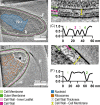Phylogenetic diversity of core rumen microbiota as described by cryo-ET
- PMID: 37223726
- PMCID: PMC10117717
- DOI: 10.1093/femsml/uqad010
Phylogenetic diversity of core rumen microbiota as described by cryo-ET
Abstract
Microbial taxonomy is critical for describing ecosystem composition, yet the link between taxonomy and properties of microbes, such as their cellular architecture, remains poorly defined. We hypothesized that the cellular architecture represents microbial niche adaptation. We used cryo-electron microscopy and tomography to analyze microbial morphology in order to associate cellular architecture with phylogeny and genomic contents. As a model system, we chose the core rumen microbiome and imaged a large isolate collection covering 90% of its richness at the order level. Based on quantifications of several morphological features, we found that the visual similarity of microbiota is significantly related to their phylogenetic distance. Up to the Family level, closely related microbes have similar cellular architectures, which are highly correlated with genome similarity. However, in more distantly related bacteria, the correlation both with taxonomy and genome similarity is lost. This is the first comprehensive study of microbial cellular architecture and our results highlight that structure remains an important parameter in classification of microorganisms, along with functional parameters such as metabolomics. Furthermore, the high-quality images presented in this study represent a reference database for the identification of bacteria in anaerobic ecosystems.
Keywords: anaerobic microorganisms; cellular architecture; cryo-electron microscopy; cryo-electron tomography; gut microbiome; rumen microbiome; taxonomy.
© The Author(s) 2023. Published by Oxford University Press on behalf of FEMS.
Conflict of interest statement
None declared.
Figures






Similar articles
-
Heritable Bovine Rumen Bacteria Are Phylogenetically Related and Correlated with the Cow's Capacity To Harvest Energy from Its Feed.mBio. 2017 Aug 15;8(4):e00703-17. doi: 10.1128/mBio.00703-17. mBio. 2017. PMID: 28811339 Free PMC article.
-
Gastrointestinal Biogeography of Luminal Microbiota and Short-Chain Fatty Acids in Sika Deer (Cervus nippon).Appl Environ Microbiol. 2022 Sep 13;88(17):e0049922. doi: 10.1128/aem.00499-22. Epub 2022 Aug 11. Appl Environ Microbiol. 2022. PMID: 35950850 Free PMC article.
-
Divergent functional isoforms drive niche specialisation for nutrient acquisition and use in rumen microbiome.ISME J. 2017 Apr;11(4):932-944. doi: 10.1038/ismej.2016.172. Epub 2017 Jan 13. ISME J. 2017. PMID: 28085156 Free PMC article.
-
High-throughput Methods Redefine the Rumen Microbiome and Its Relationship with Nutrition and Metabolism.Bioinform Biol Insights. 2014 Jun 8;8:109-25. doi: 10.4137/BBI.S15389. eCollection 2014. Bioinform Biol Insights. 2014. PMID: 24940050 Free PMC article. Review.
-
The Road Not Taken: The Rumen Microbiome, Functional Groups, and Community States.Trends Microbiol. 2019 Jun;27(6):538-549. doi: 10.1016/j.tim.2018.12.011. Epub 2019 Jan 21. Trends Microbiol. 2019. PMID: 30679075 Review.
Cited by
-
Opportunities in optical and electrical single-cell technologies to study microbial ecosystems.Front Microbiol. 2023 Aug 25;14:1233705. doi: 10.3389/fmicb.2023.1233705. eCollection 2023. Front Microbiol. 2023. PMID: 37692384 Free PMC article. Review.
References
-
- American Society for Microbiology, Bergey DH, Breed RS. Bergey’s Manual of Determinative Bacteriology, by Robert S. Breed [and Others]. Baltimore: Williams & Wilkins Co, 1957.
LinkOut - more resources
Full Text Sources
Molecular Biology Databases
Research Materials
